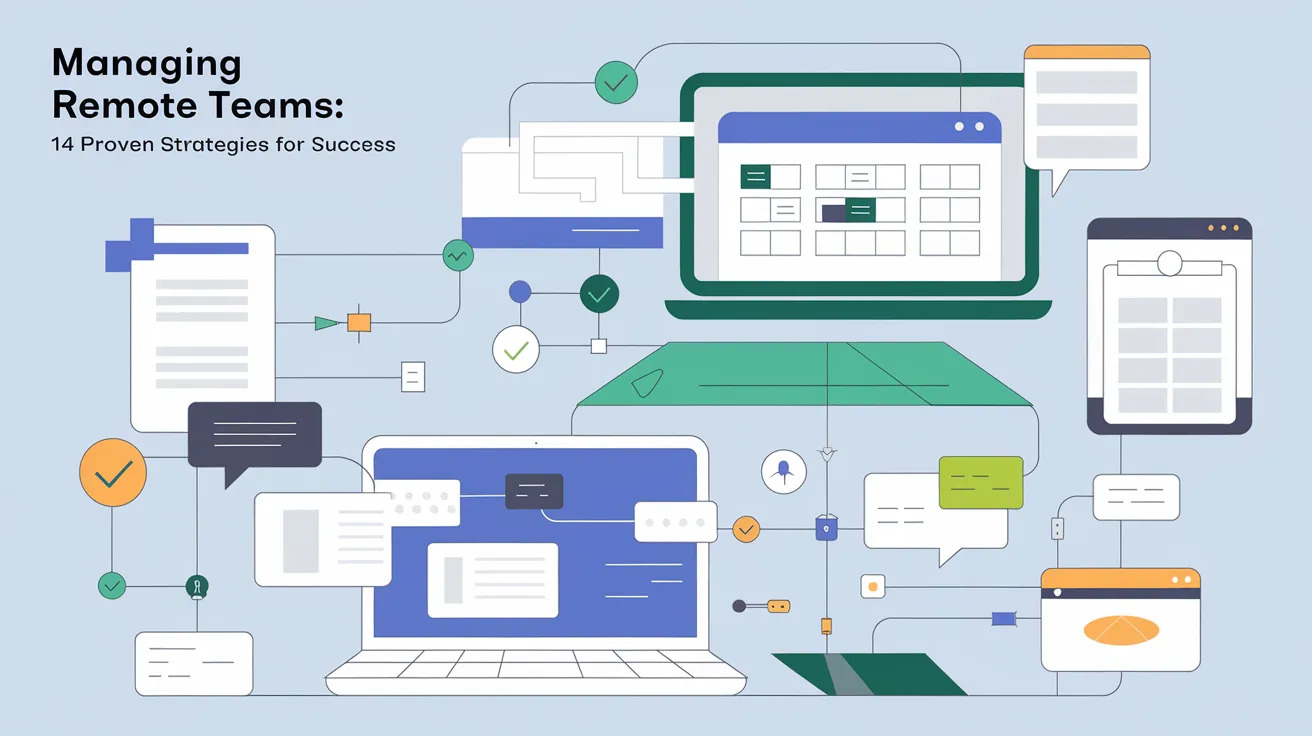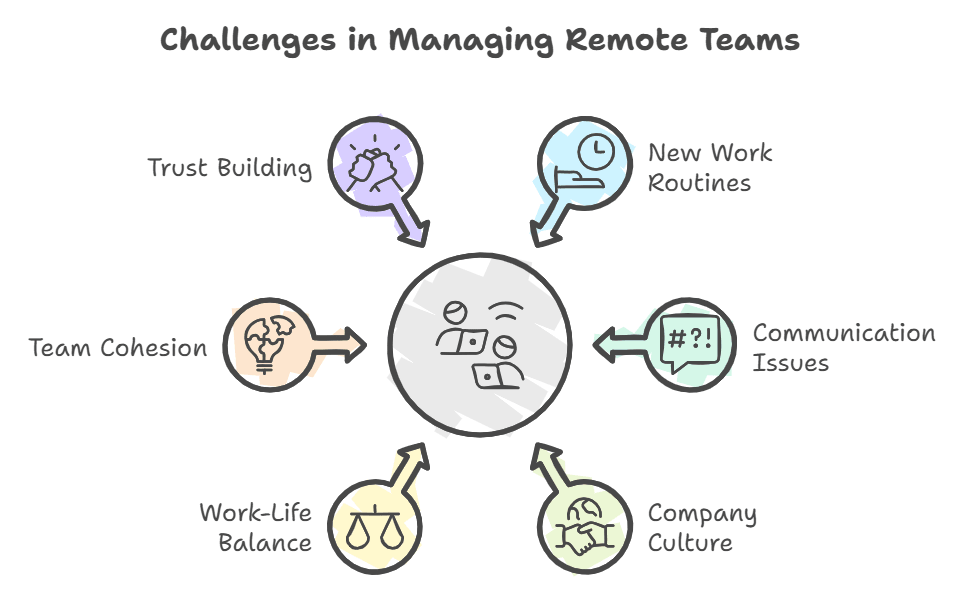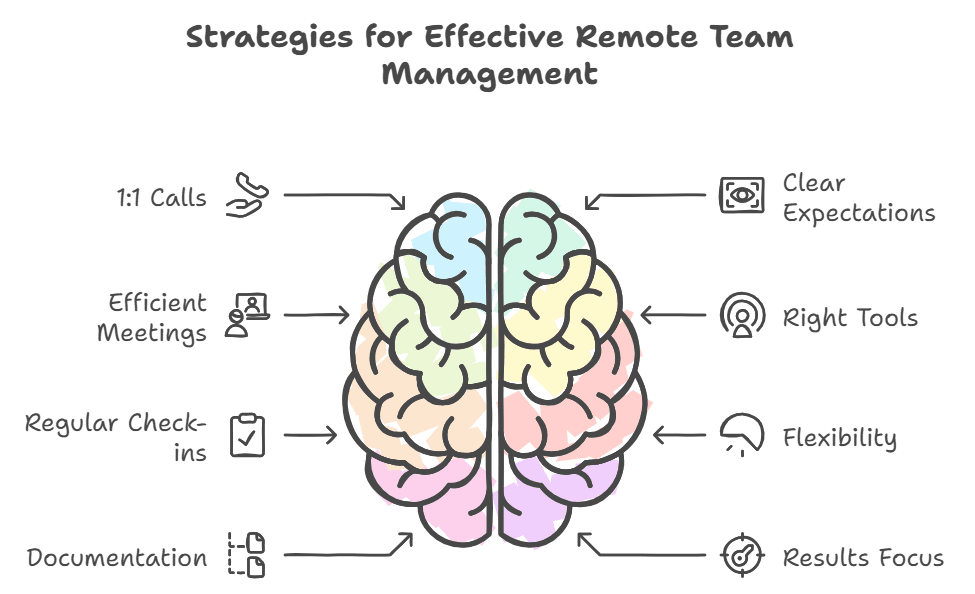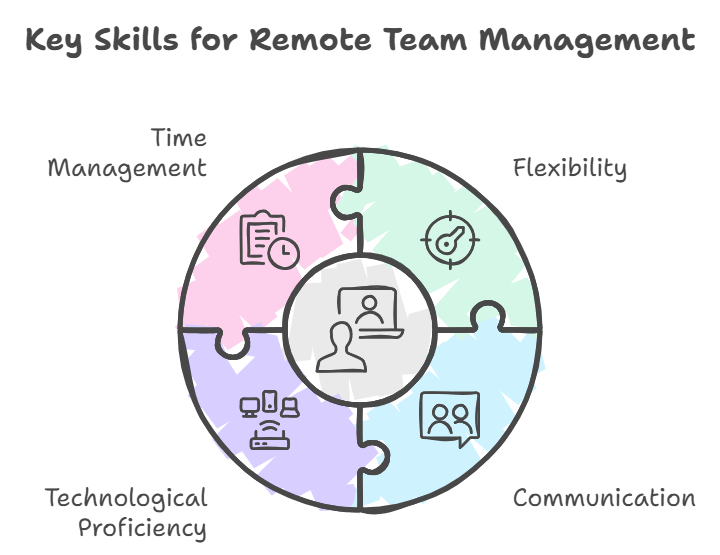Managing Remote Teams: 14 Proven Strategies for Success in 2025

Research indicates that remote workers may feel less connected to their bosses. In that case, it’s obvious that managing remote teams is full of challenges.
That said, you can manage remote teams effectively by having regular meetings, communicating clearly, and providing flexibility. Plus, you should set clear expectations, allow for flexibility, focus on results, give positive feedback, and prioritize mental health and trust.
That’s not all, I’ll also share —
- Challenges when managing a remote team
- Managing remote teams' best practices
- Key tools to increase remote productivity
- Skills every manager needs to manage a remote team
Ready to take your remote team management to the next level? Let’s get in!
Common Challenges for Managing A Fully Remote Team
When it comes to managing remote team members, there are a few obvious challenges. And I believe you should know about them as well.

Adapting to a New Work Routine
As a habit-focused species, we all get used to our routines!
From the usual morning routine to closing down at night, we tend to follow familiar patterns.
Now that you're in a remote working environment, everything feels different. You're trying to balance personal tasks with work, all in the same place. Also, you're learning new tools, getting used to virtual meetings, and figuring out new work rules.
Working from home means changing your routine. It can be a big adjustment with communication breakdowns and emotional challenges. However, with time and individual efforts, things can get sorted.
Communication
In my experience managing remote teams, communication issues can be one of the key challenges to overcome. And it’s a delicate matter when 34% of remote employees aren't sure how well they can work together online.
Yes, tools like Slack, Discord, and Teams keep us connected. However, they don’t replace the value of in-person meetings and social interaction.
Besides, when you rely too much on text messages, it's easy to miss important cues like tone of voice and body language.
It can lead to confusion and a negative impact on employee morale!!
Maintaining Company Culture
While managing remote team challenges, I’ve realized that it’s tough to maintain a strong company culture. A 2022 study showed that 66% of leaders agree culture matters more than business strategies, and I see why.
Without the physical proximity and daily face-to-face interactions, it’s harder to build connections and reinforce company values. That’s why, I focus on virtual hangouts, team-building activities, and promoting open communication across the board.
Balancing Work and Life
When we’re in an office-based environment, it’s easier to keep work and home separate. But in a remote workplace, the lines blur quickly.
When you work from home, it's easy to mix up your work time and personal time. – Dan Springer, Former CEO of DocuSign.
It’s easy for household tasks to distract you from work or for work to spill into family time. So, both managers and employees face the challenge of maintaining a healthy balance.
It’s not always easy, but finding that balance is vital, and sometimes it requires extra effort and clear ground rules.
Keeping the Team Together
Managing a fully remote team and keeping them engaged can be tough. And it’s especially true when some people prefer to work alone.
Some people like casual activities, while others find them boring or pointless. Here's what works for me —
- I create simple chat rooms on Slack or Teams for things like pets, food, or hobbies. It lets people connect naturally.
- Also, I try to keep online events relaxed, like book clubs, games, or lunch meetings.
- Using video during meetings makes it more personal and helps people feel closer.
Building Connection and Trust
Building trust in remote teams isn’t easy. Without in-person interaction, misunderstandings can happen more often.
Besides, I find it hard to read how my employees are feeling without non-verbal cues. Trust is the key to remote work's success.
Plus, micromanaging is a mistake. It can damage trust and discourage teamwork.
Further Read: 12 Common Time Wasters in the Workplace
What Are the Best Practices for Managing Remote Teams?
Managing remote teams has its challenges. However, I’ve found that with the right approach, you can build a strong and efficient remote team.
I’m here to share practical strategies that have worked well for many, and they’re very likely to work for you, too.

1. Focus on 1:1 Calls
Individual check-ins through 1:1 meetings are an excellent opportunity to connect with your team members personally. Instead of just focusing on work updates or company goals, you should use this time to ask how they’re doing.
Both at work and in their personal lives!
I make sure they have everything to get their job done. Showing genuine interest in their well-being not only boosts morale but also strengthens trust within the team.
2. Set Clear Expectations for Each Team Member
When managing a remote team, setting clear expectations is key. According to global data, 34% of people who work from home feel closer to their company when their employees are honest and open with them.
And you can do that by ensuring each team member understands their role, goals, and deadlines. Plus, reiterate the importance of each task and how it fits into the broader goals of the entire team.
And please, don’t assume they remember everything! So, I occasionally revisit the basics to ensure nothing is missed.
Be patient but firm, and encourage open dialogue to solve any uncertainties early on.
3. Design Meetings With Efficiency
A study of 182 senior managers found that most thought their team meetings were not productive or efficient. So, to keep remote meetings productive, focus on efficiency. For your team, you can —
- Set a positive tone from the start to improve engagement and creativity.
- Start with a clear agenda and stick to it.
- Begin and end on time to avoid delays and maintain momentum.
- Plus, use apps like Mentimeter, Klaxoon, and Poll Everywhere to gather real-time communication or votes during meetings.
Chat room features can serve as a secondary communication channel. It helps the participants to signal when they want to speak.
4. Have the Right Tools
To effectively manage remote teams, you must have the right communication tools. I use —
- Slack or Microsoft Teams keep remote communication smooth.
- Project management tools like Trello or Asana to organize tasks and track progress.
- For file sharing, use Dropbox or Google Drive to ensure everyone has easy access to important documents.
- Time management tools like Apploye or RescueTime increase productivity by helping workers stay focused.
- Apploye to track employee work hours and ensure tasks stay on schedule.
So, pick the best collaboration tools for your team to stay organized, connected, and working well together.
Further Read: 30+ Best Productivity Tools for Remote Teams
5. Schedule Regular Check-ins
Daily check-ins are useful for managing remote teams. That said, you must find the right balance. A quick meeting at the beginning of the day helps set direction, while a short end-of-day check-in can track progress.
However, I’ve learned that too many check-ins; especially without a clear purpose can overwhelm the team!
Sometimes, it can break down trust.
So, instead of hovering, you should let your team work independently. Only step in when necessary.
Instead of constantly checking in on them, I think a couple of focused meetings would be enough to keep things on track.
Further Read: The Pros and Cons of Employee Monitoring
6. Allow for Flexibility
One of the biggest perks for employees is the flexibility that remote work offers. That’s why, I try to let my team adjust their schedules around personal priorities.
Well, someone could be picking up their kids or taking an afternoon run. You don’t need to add unnecessary restrictions. Yes, I understand that we do need some structure and shared work hours for meetings.
That said, I’d suggest avoiding setting too many rigid rules.
7. Document Everything
Without clear guidelines, things can easily fall apart. So, document everything!
Plus, make sure that all processes, responsibilities, and deadlines are written down and shared. Also, simple checklists, templates, and flowcharts can help your team clearly understand their tasks and deadlines.
On top of that, make sure all documents are kept in one easy-to-find place so nobody has to waste time looking for them.
As Liz Lockhart Lance, Chief of Staff @ Performica says, “People need to find information easily, especially when they work from different places, as that's all they have to go on".
8. Prioritize Results Over Activity
It's tempting to watch your remote team closely! However, what matters most is their work, not how much time they spend working.
A recent study showed that remote workers can save about 72 minutes daily. Let your employees decide how they work. It’ll make them feel more involved and creative.
It doesn't matter if your team isn't always online for eight hours a day. What matters is that they get their work done and meet their goals.
Further Read: 5 Best Ways to Measure Employee Productivity
9. Keep a Close Eye on the Workload
It can be tough to know if your employee is feeling overwhelmed. That’s why I mentioned checking in regularly.
Sometimes, employees work too much without saying anything, especially when work and personal life mix. So, I ask my team about their work and look for signs of being overworked, like always working extra hours.
In that case, Apploye is a helpful tool that can track how much time employees work and what they do. It takes screenshots and monitors their activity, so you can see in real-time what your team is working on.
10. Provide Professional Development Opportunities
According to the World Economic Forum, 44% of employers think that nearly half of their workers' skills will be out of date in the next few years.
So, you must help your remote team grow by offering opportunities for professional development. Remote work shouldn't limit career growth.
That’s why I encourage my team to take on new roles, build skills, and tackle projects that challenge them. Whether it's through training, mentorship, or practical experience, these opportunities keep them motivated and engaged.
11. Give Consistent Recognition
Look, it's not just about the paycheck! Your employees want to feel valued for their efforts. A simple thank-you, a small bonus, or a thoughtful gift can make a big difference.
A recent study found that employees who are recognized for their work once a month feel more motivated and satisfied with their jobs.
So, show your team how much you care. You can do this by sending them care packages or having online parties through Google Meet. These little things, big or small, will make them feel valued.
12. Encourage Socializing at Home
Remote work environments can feel isolating, affecting well-being and productivity. A study by Zippia found that half of remote workers felt lonely at least once a week in 2022. Plus, 19% of them said that isolation was their biggest challenge.
To help your team stay connected, offer casual, low-stress activities like virtual coffee chats or game sessions. You can also encourage your employees to join outside groups or hobby clubs and share their learning with the team.
I love planning virtual happy hours or pizza parties, but I try to keep them casual to avoid getting overwhelmed.
13. Prioritize Mental Health and Well-being
The flexibility is great in remote environments! However, isolation can soon take a toll on mental well-being.
In fact, The World Health Organization (WHO) reports that depression and anxiety cause global productivity losses of $1 trillion every year.
So when you’re managing a remote team, keeping an eye on mental health becomes even more critical. Here are a few things that helped me and could help you too —
- Offer help for mental health, such as counseling or therapy.
- Talk openly with your team about how they feel; sometimes, a direct message can make a big difference.
- Share information on self-care and good work habits.
- Ask your team to take breaks, move around, and change their workspace.
If these steps aren’t enough, consider seeking professional guidance.
14. Focus on Mentorship, Not Just Management
Working from home can make it tough to stay in touch with your team. But now, more than ever, it's important to be a mentor.
Don't just focus on getting work done. Spend time teaching and guiding others.
Everyone has different communication preferences. Some like quick chats, while others need longer talks. To make everyone feel comfortable, offer different ways to talk, like phone calls, Slack chats, or video calls.
In the end, instead of planning more formal meetings, let's create time for natural, unplanned chats.
Further Read: 8 Biggest Project Management Challenges and How to Overcome Them
What Skills Do You Need for Effectively Managing A Remote Team?
A Harvard study during the start of COVID-19 showed that 4 in 10 managers weren't ready to handle work-from-home teams, while 41% found it hard to keep their remote workers motivated and connected.
It highlights the importance of having skills to manage your remote team.

Flexibility
Being adaptable is crucial for effectively managing a remote team. Working remotely has changed a lot over the years, and I've had to adjust to keep doing my job well.
So, you must stay on top of the latest trends and adapt your management style to fit your team's changing needs. Don’t be stubborn like “me way or highway! You should be flexible to succeed in remote management.
Communication
Effective communication is vital when leading remote teams.
Look, we often rely on asynchronous communication. That’s why you must provide simple, direct instructions and respond quickly to any questions that arise.
When you can't see someone in person, it's harder to understand what they really mean. So, I try to be very clear in my messages to make sure people get the right idea.
I’d therefore suggest that you tell your team to ask questions if they're confused.
Technological Proficiency
Basic technical know-how is vital when you’re managing a remote project team.
While you don’t need to be an IT expert, you should handle simple tasks like connecting hardware or adjusting monitor settings.
It’s also vital to be proficient with the tools your team uses daily. If you struggle with technology, there are ways to improve, such as online tutorials or courses.
Time Management
In my experience managing remote teams, good time management is absolutely vital. I do the following things to manage time
- Make a list of things you need to do, but be ready for anything.
- Talk to your team often to make sure everyone is on the same page.
- Do the most important things first so you don't have to rush later
- Learn to say no to avoid feeling stressed.
- Set clear limits to get rid of distractions and focus on one thing at a time.
With some planning and discipline, managing time effectively can become second nature.
Tools like Apploye can simplify your workflows. It offers time tracking and detailed productivity insights to optimize team efficiency.
Conclusion
Managing remote teams comes with its own set of challenges. It's important to find a good balance between work and home life, make sure everyone is on the same page, and build a friendly team atmosphere.
To keep remote workers motivated and productive, be clear about what's expected, use the right tools, and be flexible. As remote work grows, adapting to these changes is key to success.
FAQs
How do you effectively manage a remote team?
You can effectively manage a remote team by providing clear expectations for your team. Let everyone know what's expected of them, when and how frequently to connect, and when to share project updates.
How do you manage multiple teams remotely?
To manage multiple teams remotely, establish clear roles and expectations, encourage regular communication, and use project management tools. Plus, assign tasks to the right people, promote transparency, and encourage collaboration.
What is the best leadership style for managing virtual teams?
The best leadership styles for managing virtual teams are adaptive leadership, transformational, and servant. These methods help solve problems like poor communication, trust issues, low employee engagement, and work-life balance in remote work.